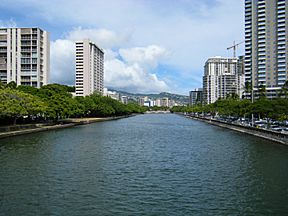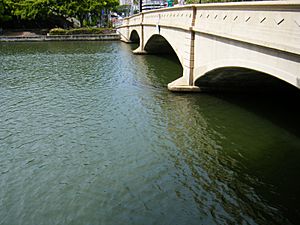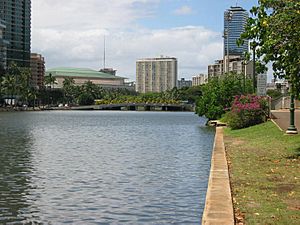Ala Wai Canal facts for kids
Quick facts for kids Ala Wai Canal |
|
|---|---|

Ala Wai Canal
|
|
| Specifications | |
| Length | 1.5 miles (2.4 km) |
| Status | Open |
| History | |
| Construction began | 1921 |
| Date completed | 1928 |
| Geography | |
| Start point | Manoa and Palolo Streams (tributary) |
| End point | Ala Wai Harbor, Pacific Ocean |
The Ala Wai Canal is a man-made waterway in Honolulu, Hawaii. It forms the northern border of the popular tourist area called Waikiki. The canal was built in 1928. Its main purpose was to drain the rice fields and swamps that used to cover the land where Waikiki now stands. It also helps carry water from rivers and streams in central and east Honolulu out to the ocean.
The canal starts near Kapahulu Avenue. It runs along the entire length of Waikiki. Then, it turns southwest and flows into the Pacific Ocean. You can cross the canal using bridges at McCully Street, Kalākaua Avenue, and Ala Moana Boulevard. Ala Wai Boulevard runs next to the canal on its west side in Waikiki.
Contents
History of the Canal
Before the Ala Wai Canal was built, Waikiki was mostly wetlands. These wet areas were fed by streams flowing from the Makiki, Palolo, and Manoa valleys. The water from these streams eventually reached the sea.
In the early 1900s, a man named Lucius Pinkham had an idea. He was the head of the Territorial Board of Health. Pinkham suggested building a drainage canal to clear these wetlands. He thought they were "unsanitary," meaning unhealthy. His plan for the canal was approved by the Board of Health. However, it only got final approval after Pinkham became the Governor of Hawaii.
Building the Canal
Construction of the canal began in 1921. It was built by Walter F. Dillingham's company, Hawaiian Dredging Construction Company. The project was finished in 1928. As the city gave permits for new buildings in Waikiki, they required builders to raise the land above sea level. Dillingham sold the dirt and mud that was dug out to create the canal. Builders used this material to make the new land higher. The canal is still regularly cleaned out, or dredged, today.
The canal changed how streams flowed into the ocean. This created many square miles of new land. Many people, even those who were not rich, benefited from this development. They had owned small rice and bean farms in the area. Creating this new land was very important for Waikiki. It helped Waikiki become the famous tourist spot it is today.
Original Design
The Ala Wai Canal was first planned to have two openings to the ocean. One was at each end of its two-mile length. These openings would help flush out dirt and mud into the ocean. However, engineers decided not to build the eastern opening. This opening would have been near Kapiolani Park and the Waikiki Natatorium. They realized that pollution from that end might wash onto Waikiki Beach.
Important Concerns About the Canal
One big worry for experts is that heavy rain could make the canal overflow. If this happened, areas from Diamond Head to Ala Moana and Moiliili could be covered by up to five feet of water. To stop this, the U.S. Army Corps of Engineers has looked at different solutions. These include digging the canal deeper, making the McCully bridge wider, and adding walls along the canal.
Pollution in the Canal
Another major problem is pollution in the canal. This pollution comes from city runoff and growing neighborhoods. For example, mercury was found in the canal. This mercury came from boat paint used in the Ala Wai Harbor. A report from 1976 also stated that the canal water often had too much fecal coliform. This is a type of bacteria that shows high levels of germs.
The canal has been cleaned out, or dredged, at least three times. This happened in 1967, 1978, and 2002. Most of the dredged material was put into the ocean. However, some material from the 2002 dredging was too toxic. Instead, it was used as landfill at Honolulu International Airport.
2006 Sewage Spill
In March 2006, heavy thunderstorms caused a sewage pipe to break near the Ala Wai Canal. Days later, the mayor at the time, Mufi Hannemann, decided to release a lot of untreated sewage into the canal. This was done to prevent sewage from backing up into hotels and homes. This action caused the canal to overflow in some places. The sewage then polluted Waikiki and nearby beaches.
Beaches near the Ala Wai Canal, including those in Waikiki and Ala Moana, were closed for a while. This was due to health concerns. The beaches eventually reopened weeks later. However, it took several months for the Ala Wai Canal to be declared safe again.
Despite the canal not always meeting safety standards for water sports, people still use it. Hundreds of paddlers and boaters make it one of the most used waterways in Hawaii.
Images for kids




